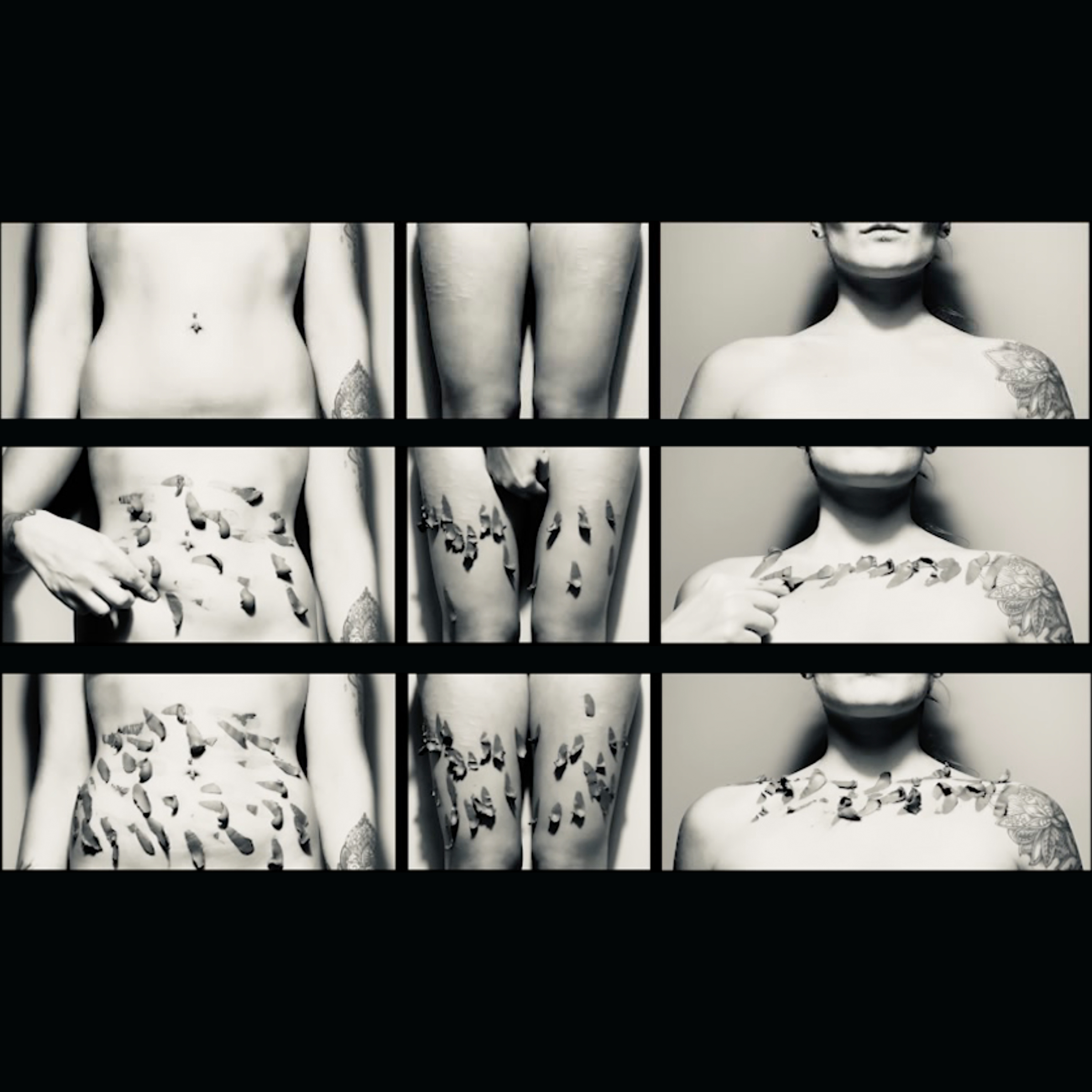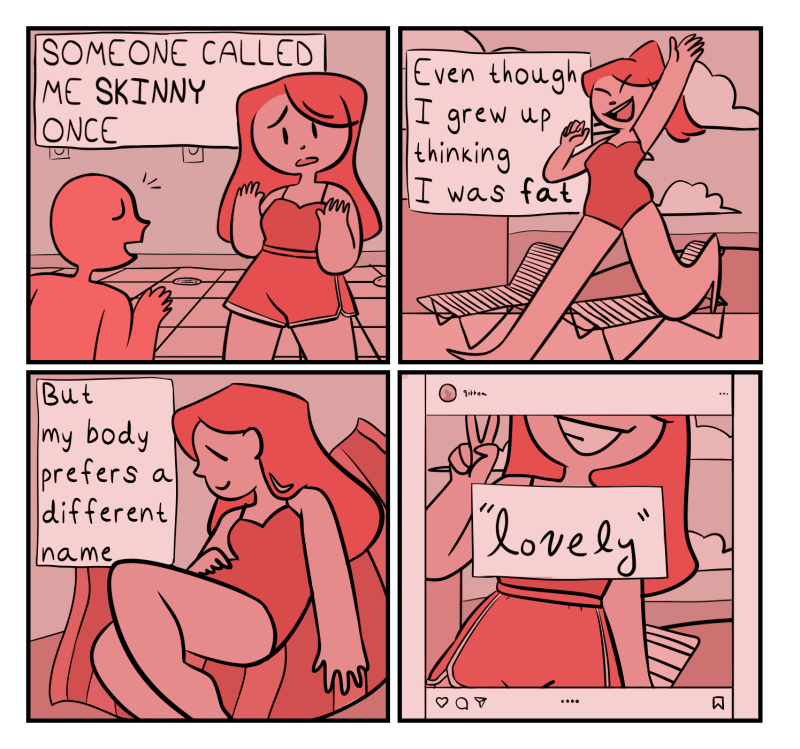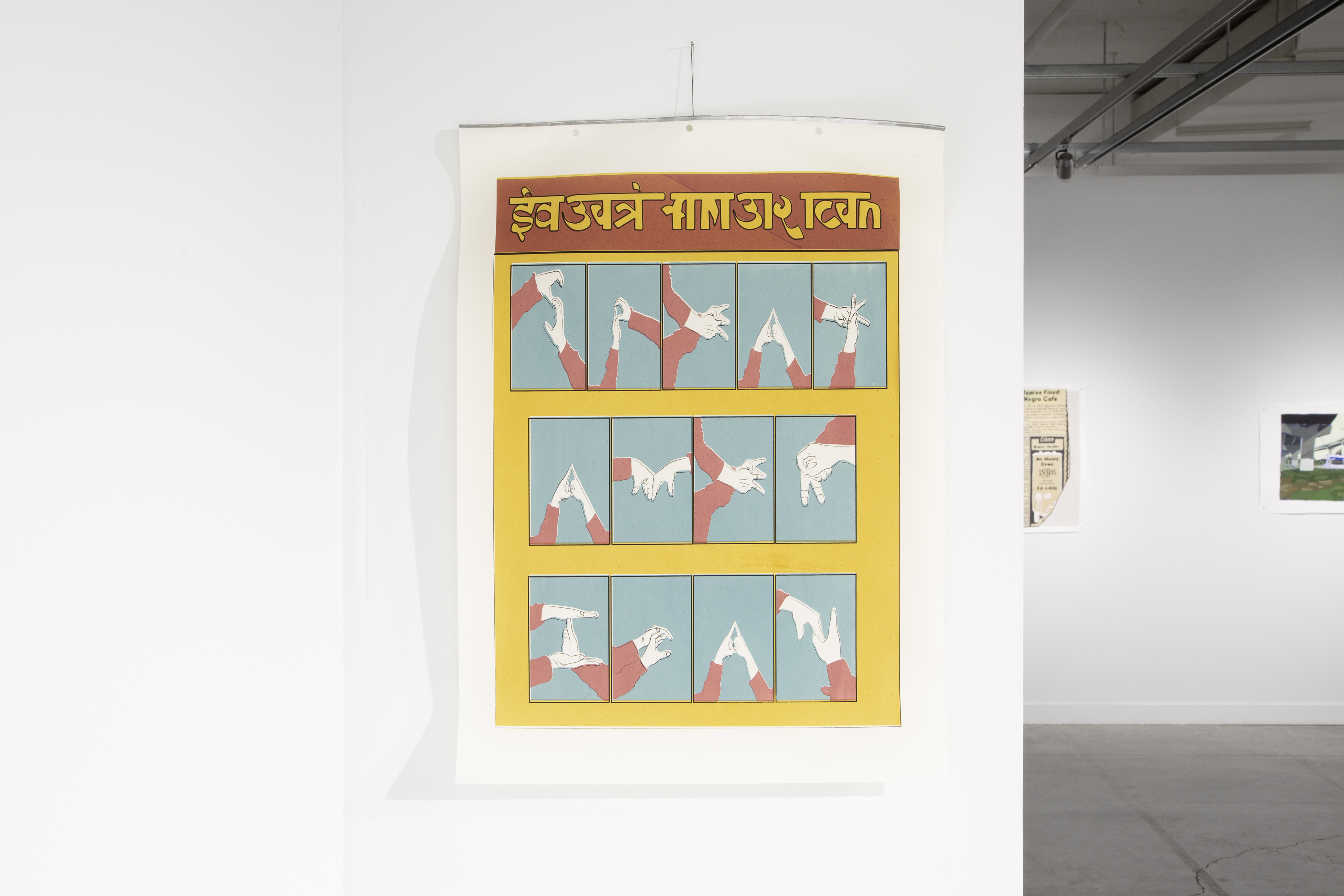
To Be Seen, To Be Heard, To Belong is an exhibit showcasing the diverse experiences and backgrounds of the student community. Residence Life invited undergraduate and graduate students to submit artwork sharing their unique stories.
Special thanks to the Disability Studies Program of the Department of English in the College of Arts and Sciences for providing image descriptions.
The opinions and views expressed in this collection are solely those of the artists and do not reflect opinion or views of the university.

Judith Diehl
Unitited, 2020
Clay and Digital Stills
18 x 24 inches
Judith Diehl
This work was a personal breakthrough. In a moment of anxiety and frustration, where I would typically disintegrate into a trembling pool of tears and negative behaviors, I instead sat down with a ball of clay. I sat with my clay, felt its coolness against my skin, and began to pull it apart angrily and wipe it onto a wooden wareboard. After a few minutes, not only had my breathing slowed, but I looked down to see that I had created a beautiful texture with pieces of clay that held onto my fingerprint. Out of curiosity, I attempted to create the same texture on my body and soon realized the breakthrough I had just made. I curbed an anxiety attack, by myself, with no harmful behaviors and with healthy coping mechanisms. The realization hit me that this texture of fingerprints I was creating was less about its beauty and more about the control I have over my own body. This work, this performance, process, film, and experience, is a tremendous milestone in my recovery.

Gabriella Stauffer
Note to Self, 2020
Digital Illustration
11 x 8.5 inches

Gabriella Stauffer
Body Positivity, 2020
Digital Illustration
12 x 12 inches
Gabriella Stauffer
I make myself: My perspective is the only perspective I can truly understand or express. In every artwork, a piece of an artist comes through, but it is common for this “self” to be shown through abstraction, creating a blanket or wall to soften the truth about someone. I often ask “why doesn’t anybody ever really know anyone else? Why do we so often pretend to be a watered-down version of ourselves for the comfort of someone else?” It has thus become an act of activism to show something true about oneself rather than a curated, stripped-down expression, and I wish this were not the case.
To me, it feels safe to show something innately personal to others, especially through a simple graphic style, despite this vulnerability opening me up to critique or concern. I also consider how personal testimony often seems “relatable,” or relates to a wider audience than one may initially expect. Taking personal, private stories and experiences and placing them in a public view can lead to a lot of connection between people. Sometimes, someone else’s experiences help make you feel “seen," and I want more of that. In showing my inner self outwardly, I hope to spark someone else to do the same; in this, we can demystify the personal.

Gabby Holt
Church Girls Are Dead, 2021
Photograph
8.5x11 inches

Gabby Holt
Untitled
Photograph
8.5x11 inches

Gabby Holt
Women's March, 2017
Photograph
8.5x11 inches

Gabby Holt
Untitled, 2017
Photograph
8.5x11 inches
Gabby Holt
Each photograph included in this gallery is a reflection of the intersexuality of me being both a woman and Black. These photographs were taken in the timespan between 2017 to 2021. I am thankful that I get to use my voice in my own unique way which is my art. As you look at these photographs, internalize what it means for you to be as you experience what it is to be me. The people, nature, and me are all a part of a world that for so long has been discriminatory to Black women and I want to begin the process of dismantling that system and changing that narrative. To all my Black women, thank you for inspiring beyond measures and for being the catalysts of my art.
Love, Gabby.

K. Anna Kovach
Homage to Phyllis Lyon and Del Martin (The Ardent Spirit of Bilitis), 2021
Enamel on Fused Glass
8 x 6 inches (each)
K. Anna Kovach
Phyllis Lyon and Del Martin were pioneers of the queer liberation movement, and their activism has played a significant role in my life, and the lives of other women. This diptych shows Phyllis and Del in two phases of life, as young women in the 1950s only able to meet in secret and later in front of the home which they owned together in San Francisco. The earlier image is paired with writing from Del Martin’s book Lesbian/Woman, while the second is paired with a letter I had written to them. I often regret not writing to Phyllis while she was alive and choose to honor their legacy through my work.

Kelly Patrick
Boundaries, 2020
Acrylic on Canvas
40 x 30 inches
Kelly Patrick
I have always been drawn to figurative work, and I’m interested in boundaries. Moments when a shape becomes a silhouette, a color becomes defined by its surroundings, or an outline becomes a path connecting one space to another, are some of the most exciting and difficult to understand. Painting is a way to the handle difficulties of living in a human body and allows for a form of communication more intimate and honest than conversation. Where a voice falters, a line speaks firmly in its place. While we rapidly perceive one another, fragmented versions of our minds and bodies are regenerated in attempts to understand who and what we are. There is comfort in the process of learning and unlearning how we perceive ourselves and others. Shapes and colors melt until they fit together, and I am reminded of connections between people, and the way we are shaped by bits of distant conversations with strangers, or the ones we keep close.

Sydney Summey
Untitled 1 / Women’s March, 2020
Photography
20 x 16 inches

Sydney Summey
Untitled 2 / Women’s March, 2020
Photography
20 x 16 inches
Sydney Summey
This collection is a cry for an exchange. An exchange if one is willing to take the time for it. It would be one of trading ideals rooted in unacceptance for that of understanding and empathy. It would be for the tenderness of our truth that black skin holds a gentle people, a people that although have ever aching hearts for our brothers and sisters that there remains a hope, a dream, a voice, and a radical love. And it is the absolute essence of our love that drives our song, our march, and our care.

Princess Egbo
Unrest, 2020
Acrylic on Canvas Board
30 x 24 inches
Princess Egbo
Unrest is defined as a disturbed or uneasy state. Year after year, we as Black people see and hear about cases like this, the same formula and narrative. An unarmed black person, a cop, and always some reasoning on why it happened. We often hear, “He wasn’t a saint” or “They were resisting” and we are tired. I had become so desensitized to the killing of Black men, but the case of George Floyd was so unnerving and was a clear awaking of the reality of being Black in America that I’ve tried so hard to avoid. The idea of hope and optimism dying with every scroll through the internet. Hours spent reading and arguing with individuals who enjoyed living in a world of ignorance and privilege. UNREST.
I made this piece after taking a break from social media and as a way to relieve stress. I spent 18 straight hours creating this piece using the medium acrylic on canvas board.

Caeley Blechschmid
Art Knows No Body, 2019
Oil on Canvas Board
20 x 32 inches
Caeley Blechschmid
There is so much that can be told from the human figure in its purest form and with all its intricacies, and I make work to tell the story. Through realistic depictions, I capture some of the traits of the human body that are ridiculed in the media for imperfection, showing all body types and characteristics. I make visible marks, like paint strokes, that creates an essence of purposeful imperfection. Throughout our lives, our bodies change, our skin stretches, weight fluctuates, and wear and tear happen; this does not make any person unworthy of being depicted. Science groups people of the same anatomical features, and the uniqueness of each human form is lost. Through my art practice, I can learn more about anatomy while simultaneously creating pieces of work that emphasize the difference among bodies.

Jet Ni
Red China, 2020
Prints from Digital Video
16 x 9 inches (each)
Jet Ni
This piece utilizes a found video made by the United States Department of Defense in 1964 called the Red Chinese Battle Plan. This 28-minute propaganda video was created to portray China as a threat to American society and culture, with themes of anti-communism and revitalizing ideas from the earlier period of Yellow Peril fear-mongering. Despite almost six decades passing since this video was released, the recent attitudes displayed by the public shows that anti-Asian sentiments still resonate strongly among many people. As a viewer tries to make sense of the video masked into the shadows, they are also forced to hold the gaze of an Asian-American and reflect.
Throughout the majority of the COVID-19 pandemic, Trump and his administration continuously used language that blamed the pandemic on China while not taking any responsibility regarding the American government’s own lack of action in controlling the spread. Language is a powerful tool, especially in the hands of officials who hold power and influence over the general population. There was a sudden increase in anti-Asian sentiments throughout the country as many people were led to believe the rhetoric that China was the cause for all the problems happening. Anyone who looked like they were of East Asian descent were all targets, regardless of whether they had any connections to China. Reports from around the country showed various members of the Asian community being targets of hate crimes and speech, especially during the initial outbreak of the virus.
This piece utilizes a found video made by the United States Department of Defense in 1964 called the Red Chinese Battle Plan. This 28-minute propaganda video was created to portray China as a threat to American society and culture, with themes of anti-communism and revitalizing ideas from the earlier period of Yellow Peril fearmongering. Despite almost six decades passing since this video was released, the recent attitudes displayed by the public shows that anti-Asian sentiments still resonate strongly among many people. As a viewer tries to make sense of the video masked into the shadows, they are also forced to hold the gaze of an Asian-American and reflect.
Nasra Osman
Afro Queen, 2020
Digital Illustration
8.5 x 11 inches
Nasra Osman
African Queen, 2020
Digital Illustration
8.5 x 11 inches
Nasra Osman
We Are All Humans, 2020
Digital Illustration
8.5 x 11 inches
Nasra Osman
We Are All Humans, 2020
Digital Illustration
8.5 x 11 inches

Nasra Osman
Be Yourself, 2020
Digital Illustration
8.5 x 11 inches
Nasra Osman
My work expresses women’s empowerment; strong, intelligent, independent, beautiful women capable of carrying an entire world on their shoulders. These pieces celebrate the beauty of diversity in race, ethnicity, and religion. It highlights the cultural and religious aspects that make us who we are. I want my audience to remember, in a world of unrealistic standards and expectations, remember who YOU truly are and embrace the beauty of yourself. I use Arabic calligraphy to dive into my identity and add a personal touch. Additionally, these pieces bring attention to the current systemic racism against black people that infiltrated the world, be it west or east. It serves as a reminder that no matter what our skin color is, we are all one and we should all be treated with respect, compassion, and dignity.

Brett Taylor
Reconfiguration Series, 2020
Digital Collage
18 x 24 inches (each)
Brett Taylor
My work explores the relationship between queerness, masculinity, and physical ability through the queering and crippling of the male form. The body, as object, exists in a constant state of becoming. A process of uninterrupted bodybuilding by which a person orders and reorders the self, responding to resistance. Negotiations with the fluctuating spatial conditions, the body is forced to resist the environmental restrictions in an effort to grow beyond them. This stimulus for physical change is only obstructed by the will of the mind. The potential self is never realized exasperated by the failure to achieve maximum capacity. Beings strive to identify the physical boundaries that define them only to identify new ones that confine them. Growth centered around inadequacies seeks failure to strive for infinite improvement. The tension between the interior and exterior being leaves the body in a developmental state, never quite complete.

Lydia Smith
Sky Map (Jeffers Mound), 2020
Dye Sublimation Print on Silk Organza and Broadcloth, and acrylic paint
36 x 34.5 inches
Lydia Smith
While visiting Jeffers Mound (named after the family that worked to preserve the site when the surrounding land was subdivided), I took a series of panoramic photos circumambulating the mound. I walked from the left, and then from the right, my camera facing the large pile of raised earth. The mound sits at the center of a large cul-de-sac, surrounded by suburban homes. There are trees sprouting out of the top. While the language and history of the people who built these sites no longer reside in our living memory, I know the land remembers what we cannot. I imagined what it must feel like to be this mound, outliving its creators, the last of its kind. I imagined the mound staring up at the sky as the wind spiraling around it. Memories still linger and traces of the past still haunt us, reminding us what has been lost.
In September 2019 I began researching the remaining earthworks and burial mounds built 2000 years ago by Indigenous groups of people who lived on the land we now call Columbus. Ironically, this namesake is credited with the first acts of settler-colonialism, a practice of exploitation and occupation that led to demolishing of the majority of these sacred sites and erasing the remnants of their ancient history. The contemporary Indigenous caretakers of these sites were pushed off their land, the burial mounds were looted for treasure, and earthwork enclosures were flattened to make space for industrial farming.
While visiting Jeffers Mound (named after the family that worked to preserve the site when the surrounding land was subdivided), I took a series of panoramic photos circumambulating the mound. I walked from the left, and then from the right, my camera facing the large pile of raised earth. The mound sits at the center of a large cul-de-sac, surrounded by suburban homes. There are trees sprouting out of the top. While the language and history of the people who built these sites no longer reside in our living memory, I know the land remembers what we cannot. I imagined what it must feel like to be this mound, outliving its creators, the last of its kind. I imagined the mound staring up at the sky as the wind spiraling around it. Memories still linger and traces of the past still haunt us, reminding us what has been lost.
The map I have compiled from these photos is not the territory it represents. I make space for ghosts on the map and speculative fiction fills unknown gaps. I respect the mysteries of this site, the secrets that cannot be excavated by archeologists or pieced together by historians. My map presents the sky as its focal point. The sky is surrounded by the mound’s blurred embrace. I hope this map transports us to the knowledge and respect that there were people here before us, who also stared at the sky.

Shahid Khan
Speak American, 2021
Paper, Ink, Mix-Media
18 x 24 inches

Shahid Khan
American Made (Red, White, and Blue), 2021
Paper, Ink, Mix-Media
24 x 18 inches

Shahid Khan
American Made (Indian Green), 2021
Paper, Ink, Mix-Media
24 x 18 inches
Shahid Khan
My recent series American Made is a visual mediation of my experiences within the predominant Indian and American cultures, as well as their respective subcultures. In each piece, I recontextualize written language, consumer goods, or national emblems in order to examine their commonalities and distinctions. For example, I have created typographic posters that contain both English and Hindi word-forms; sculptural objects that combine baseball and cricket bats; and eating utensils that are magnetized to one another. American Made illustrates the complex nature of my multicultural experience and directs the viewer to reflect on their own, simply by examining the objects and languages they surround themselves with daily.
Summer Series is a multi-venue series that showcases short- and long-term projects such as gallery exhibitions, performances, audience participatory work, discussions, research demos and more. This series encourages collaboration, multidisciplinary approaches and seeks ideas that foster conversations, relationships, or careers, that represent diverse perspectives.
